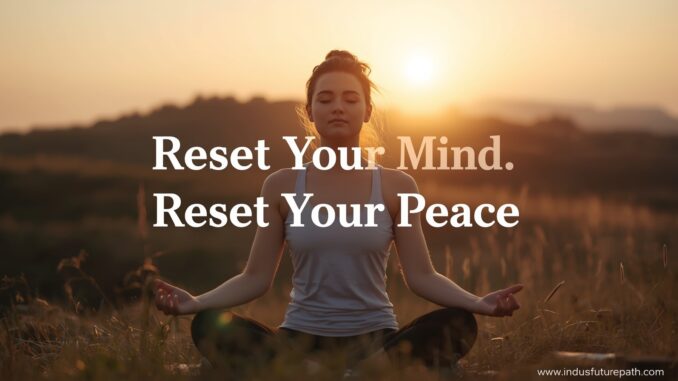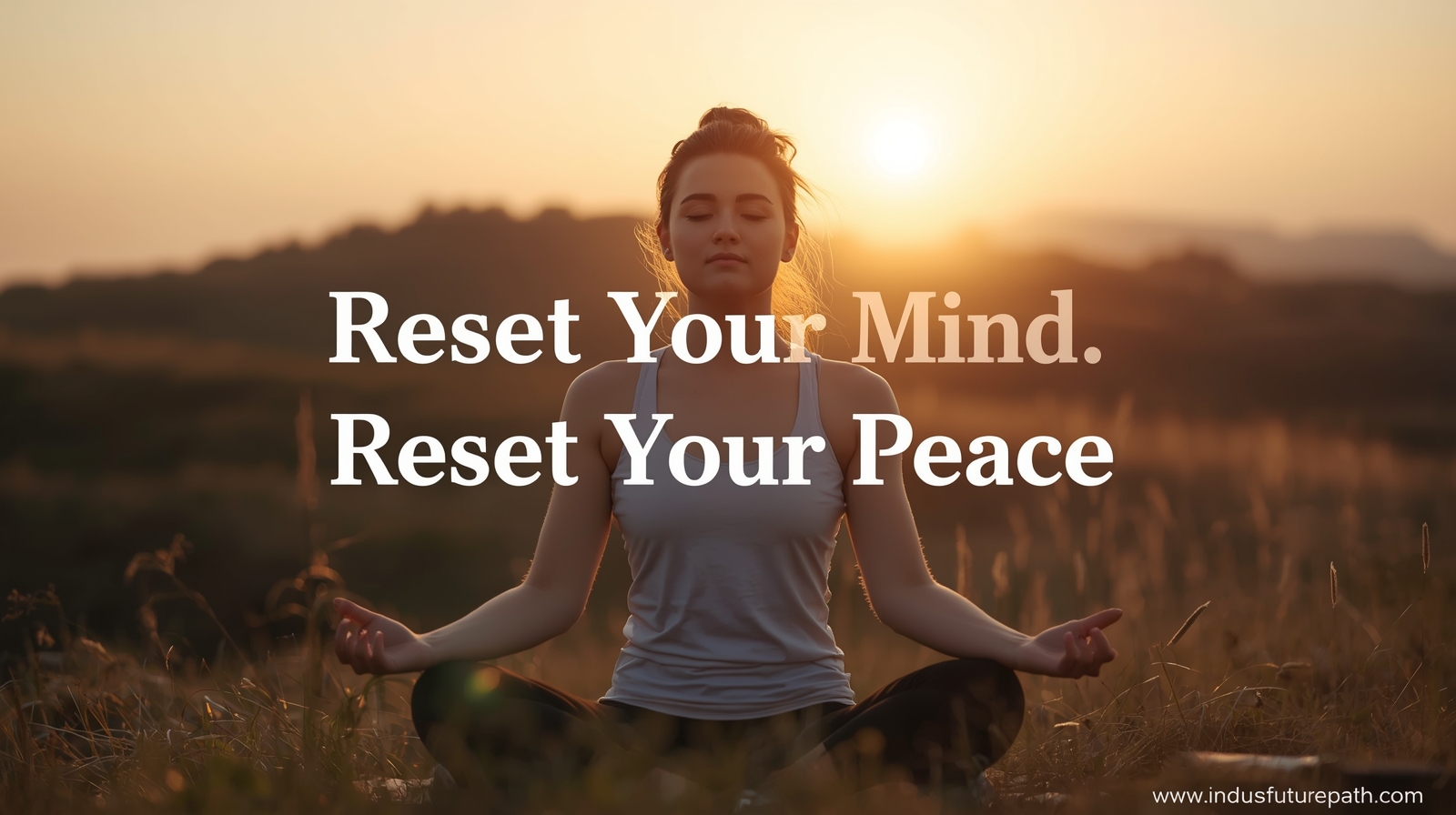
In today’s world stress feels like a constant background noise. Whether it’s work deadlines, financial pressure, family expectations, or the endless stream of news on our phones, the mind rarely gets a chance to rest. Anxiety quietly builds up tightening its grip until even small tasks feel overwhelming. Many people turn to medication or therapy , and while both can be life-changing, there’s also a gentler path that complements them natural remedies and lifestyle shifts that slowly help the body and mind return to balance.
This is not about a quick fix. It’s about gradually resetting your mental health, learning how to breathe again, and rediscovering the calm that always existed beneath the noise.

Understanding Stress and Anxiety
Before trying to manage stress or anxiety, it helps to understand what’s actually happening inside the body.
When we face a stressful situation, our brain releases cortisol and adrenaline , hormones that prepare us for fight or flight. These chemicals are useful when we need to act fast, but when stress becomes constant, they linger in our system, leaving us tense, tired, and mentally drained.
Anxiety often develops when the mind keeps anticipating threats that never fully arrive. It’s like your brain’s alarm system refuses to turn off. Over time this can affect sleep, digestion, concentration, and even immunity. But the same brain that learns anxiety can also learn calm , and that’s where natural methods come in.
Exercise: Movement That Heals the Mind
One of the simplest yet most powerful natural remedies for anxiety is movement. Exercise triggers the release of endorphins, the body’s own feel good chemicals that lift mood and reduce tension.
You don’t need any expensive gym membership or high intensity routines. Even a thirty minute walk outside can start to shift your state of mind. The rhythmic pattern of walking, the sound of footsteps, the subtle change of scenery all of it gently resets your thoughts.
A 2016 study found that people who exercised regularly felt less anxious when facing stressful events, such as quitting smoking or adjusting to a major life change. Exercise becomes a way to train resilience not just the body.
For some, yoga or swimming works best for others, cycling or jogging brings the needed release. The key is consistency not perfection. Let your movement become your therapy.
Meditation and Mindfulness: Calming the Inner Storm
Meditation isn’t about silencing thoughts it’s about learning to watch them without being pulled under. In moments of anxiety, the mind races ahead replaying fears and unfinished stories. Mindfulness practices, such as focused breathing or simple meditation, teach you to slow down and observe instead of react.
Start with five minutes a day. Sit comfortably, close your eyes, and breathe deeply. Each inhale invites peace, each exhale releases tension. When thoughts come and they will notice them gently, then return to your breath. Over time, you’ll begin to feel more centered, even in chaotic environments.
Many people find mindfulness works best when blended into everyday activities. Try mindful eating, mindful walking, or even mindful listening. The goal isn’t spiritual achievement it’s presence. Anxiety fades when you return fully to the present moment.
Relaxation Techniques: Letting the Body Unwind
Stress often hides in the body in the neck, shoulders, jaw, or stomach. Progressive relaxation can help you release it. This method involves tightening one group of muscles for a few seconds and then letting them go, noticing how relaxation spreads afterward.
Breathing exercises work in the same way. Slow, deep breathing signals the nervous system that it’s safe to relax. The simplest pattern inhale for four seconds, hold for four, exhale for four can lower heart rate and calm the body within minutes.
Try practicing this before bed, during breaks at work, or anytime you feel anxiety rising.
Writing as Therapy: The Power of Journaling
Sometimes the mind feels heavy simply because it’s holding too much. Journaling gives those thoughts a place to go. When you write about what’s bothering you, the tangle of worries starts to make sense. It’s no longer just noise in your head it becomes words on a page that you can understand, challenge, or release.
A 2018 study found that emotion-based journaling improved overall well-being and reduced distress.
You don’t need to be a writer; you just need honesty. Write about what scared you today, what made you grateful, what you wish you could change. Over time, you’ll notice patterns triggers, fears, and small victories and that awareness alone can be healing.
Organizing Life: Managing Time, Managing Stress
Anxiety often grows in the gap between what we need to do and the time we have to do it. Time management isn’t about filling every hour; it’s about creating space for peace.
When tasks pile up, the brain perceives chaos. Breaking large goals into smaller steps restores a sense of control.
Try keeping a planner or digital calendar. Prioritize what truly matters and say no to what drains your energy. It’s not selfish it’s survival. As your schedule becomes clearer, the mind relaxes. You begin to realize that productivity is not about speed; it’s about balance.
Aromatherapy: Breathing in Calm
Scents have a quiet power. They can bring back memories, change emotions, even affect hormones. Lavender, chamomile, and bergamot essential oils are often used to reduce anxiety.
A few drops in a diffuser, a warm bath, or even on a handkerchief can create a small sanctuary wherever you are.
Here’s a simple overview of commonly used calming scents:
| Essential Oil | Known Benefit | Best Way to Use |
| Lavender | Reduces anxiety and aids sleep | Diffuser or pillow spray |
| Chamomile | Soothes tension and irritability | Herbal tea or bath soak |
| Bergamot | Uplifts mood and relieves stress | Mixed with carrier oil for massage |
| Sandalwood | Grounds thoughts and promotes calm | Incense or oil blend |
Everyone responds differently, so experiment gently. The goal is not to mask emotions but to create a small sensory pause where the mind can rest.
Natural Aids: Herbal Teas and Supplements
Nature offers subtle helpers in the form of herbs and teas. Chamomile, lemon balm, and green tea are known for their calming effects.
Sipping a warm cup in the evening slows the day down, telling the nervous system that it’s time to rest.
Chamomile tea, for instance, has been found to influence cortisol levels , the body’s main stress hormone helping to regulate mood and sleep.
Still, it’s wise to consult a doctor before starting any herbal supplements, especially if you’re already taking medication. Herbs can interact with drugs, sometimes changing their effects. The idea is not to replace medical care but to support it naturally. Think of these remedies as quiet partners on your journey to balance.
CBD Oil: A Modern Natural Option
In recent years, cannabidiol (CBD) oil has gained attention for its potential to ease anxiety. Extracted from the cannabis plant, CBD does not contain THC the compound responsible for a “high.” Instead, it interacts with receptors in the brain that influence mood and stress response.
Early studies suggest that CBD may help reduce social anxiety and promote relaxation.
However, research is still ongoing, and results vary. Always choose quality-tested products and consult a healthcare professional before use. When used responsibly, CBD oil can become one more gentle tool in your self-care routine.

Healing Through Connection: The Power of Animals
Sometimes the best therapy doesn’t come in words. Spending time with animals whether it’s a dog, cat, or even fish can lower blood pressure and reduce loneliness. Pets don’t judge; they listen, comfort, and give us a reason to care for something beyond ourselves. For people with allergies or limited space, even watching fish in an aquarium or bird-feeding outdoors can have a calming effect. What matters most is the sense of connection a reminder that peace often comes through love and presence.
Building a Support System
No remedy works in isolation. One of the most healing steps you can take is reaching out to friends, family, or mental health professionals. Humans are wired for connection. Sharing your worries lightens them, even if the listener can’t fix everything.
Joining a support group, online or in person, helps you see that you’re not alone. Sometimes, simply knowing others face the same struggles brings comfort.
Therapy, particularly cognitive behavioral therapy (CBT), remains one of the most effective long-term solutions for anxiety. It teaches you how thoughts shape emotions and behavior, and how to replace unhelpful patterns with healthier responses.
Medication: When Natural Remedies Need Support
Natural solutions work best for mild to moderate anxiety, but if symptoms become overwhelming, medication can be life-saving. Doctors may prescribe short-term anti-anxiety drugs like benzodiazepines or longer-term SSRIs (selective serotonin reuptake inhibitors).
There’s no shame in needing extra help. Combining professional treatment with natural methods often brings the best results. Think of medication as stabilizing the foundation while you rebuild the walls with lifestyle changes.
Creating Your Own Mental Health Routine
Resetting your mental health doesn’t happen in a single weekend. It’s a process small, steady choices that retrain your body and mind toward calm. Start by picking two or three natural methods that feel realistic for you.
Maybe it’s a morning walk and evening journaling. Maybe it’s tea before bed instead of screen time. Consistency matters more than perfection.
The Deeper Lesson: Listening to Yourself
Perhaps the most powerful natural remedy of all is self-awareness. Anxiety thrives when we ignore our inner signals exhaustion, frustration, sadness until they erupt as panic.
Learning to listen means pausing before you reach that breaking point. It means admitting, I need rest, or I need to talk, without guilt.
Healing is rarely dramatic. It’s often quiet: a slow morning walk, a deep breath, a night of honest sleep. The more you respect your mind’s limits, the stronger it becomes.

Leave a Reply